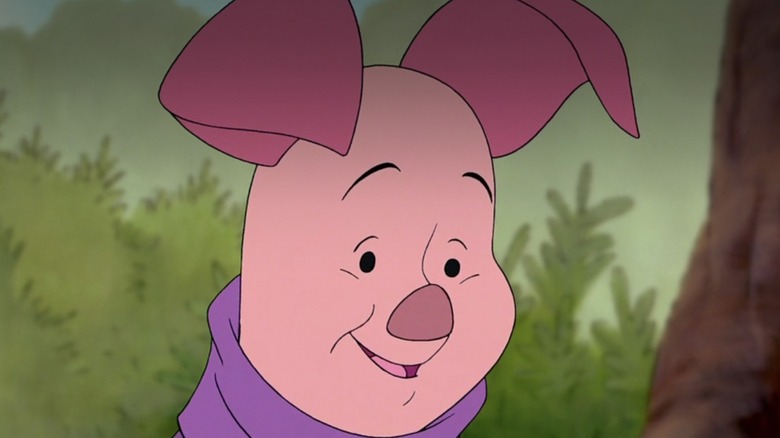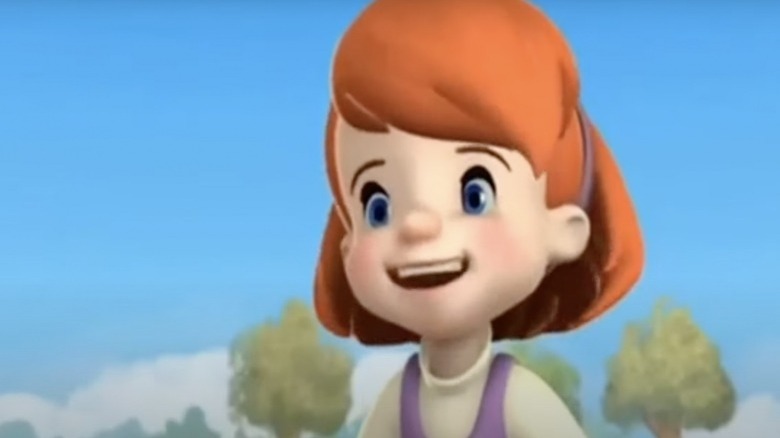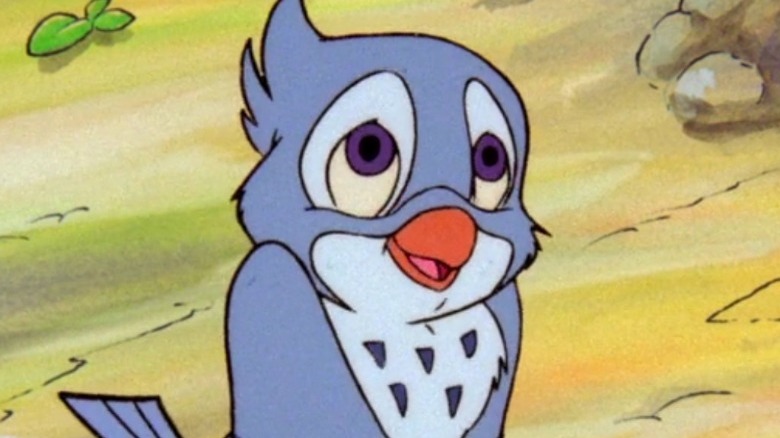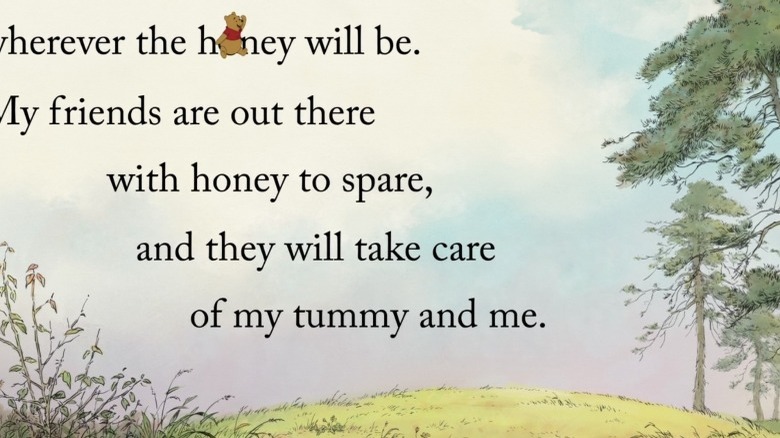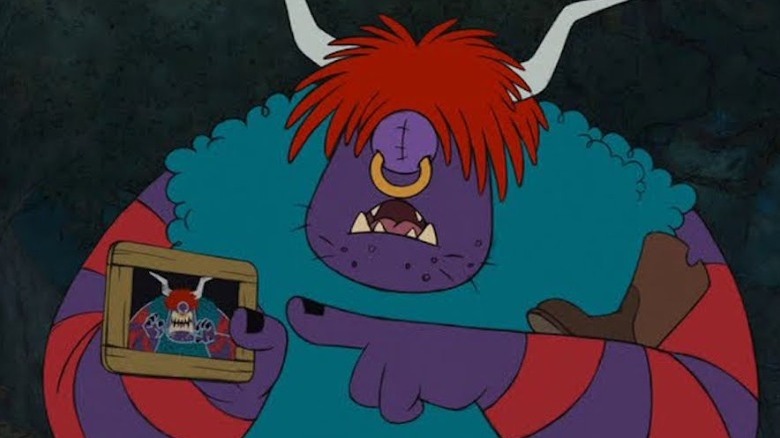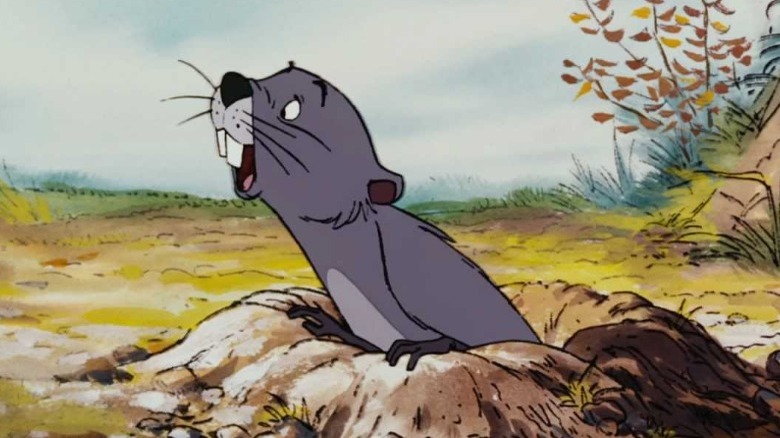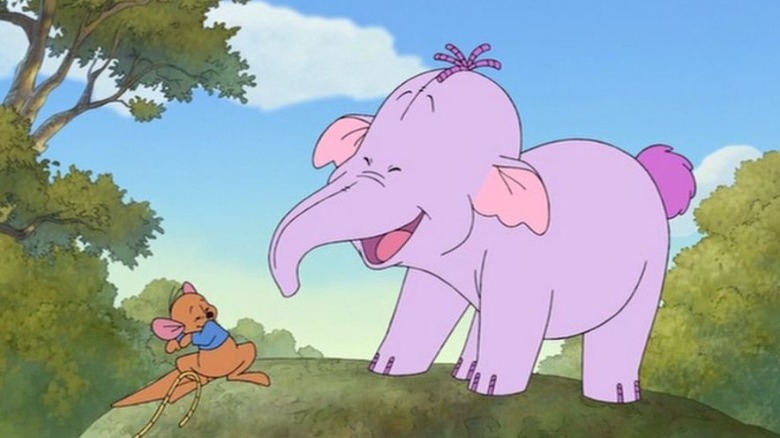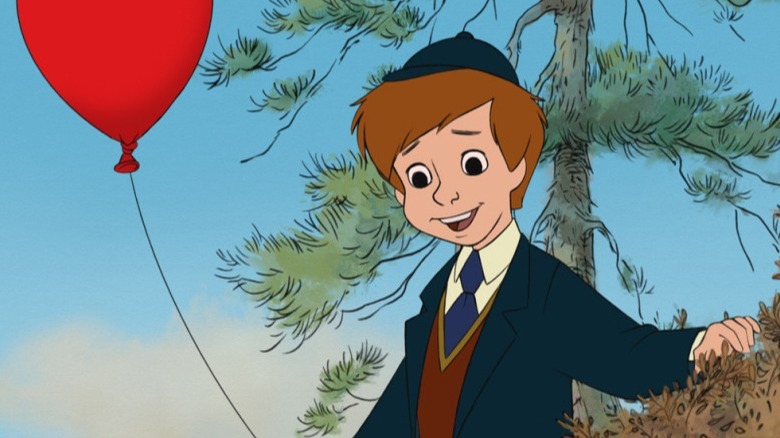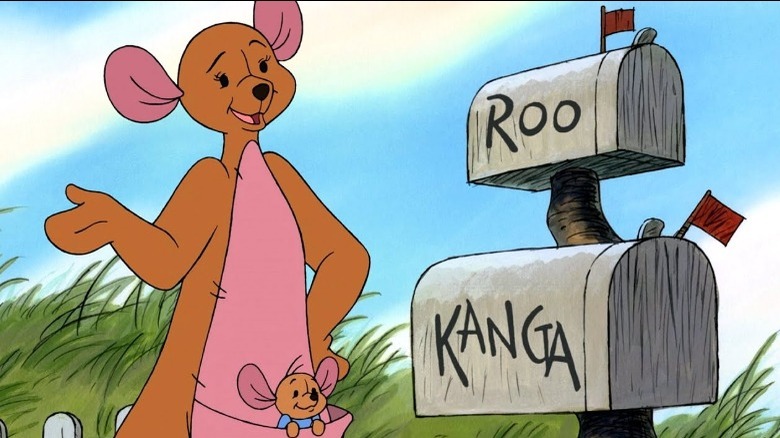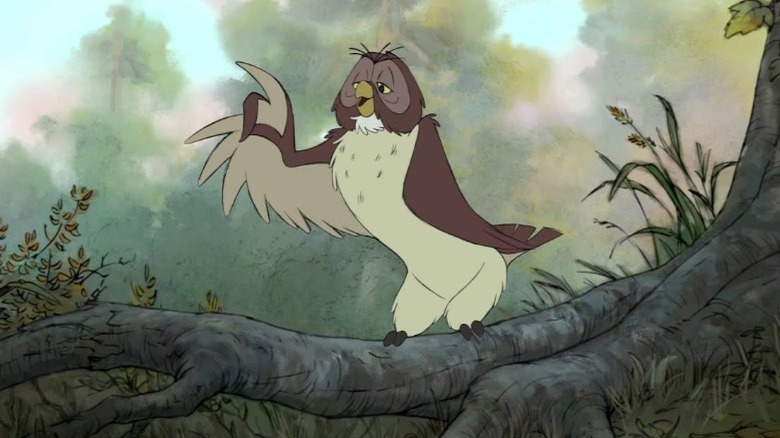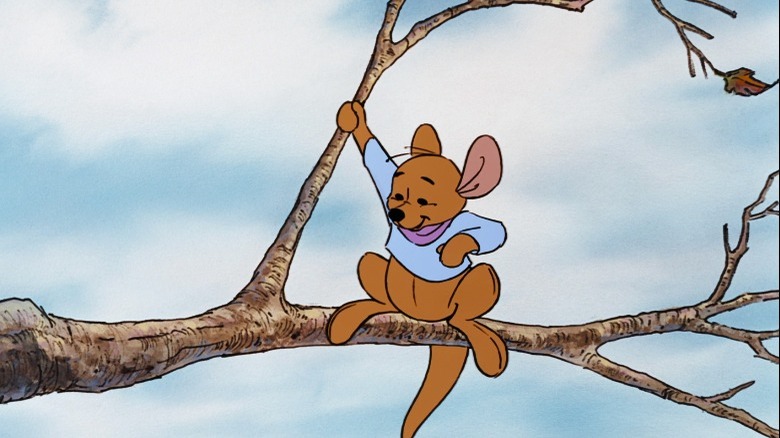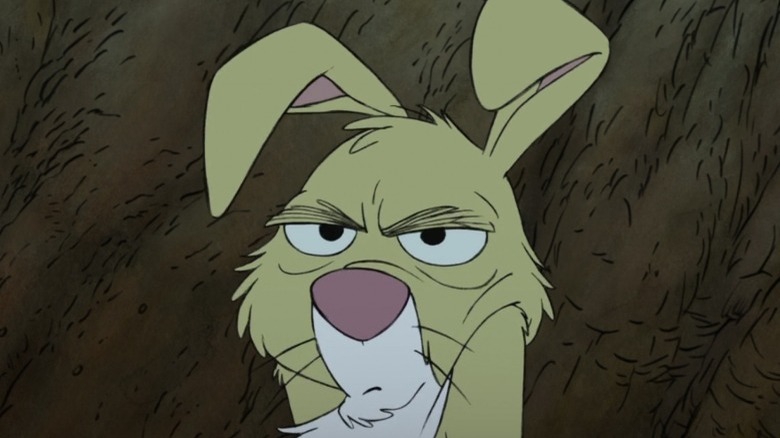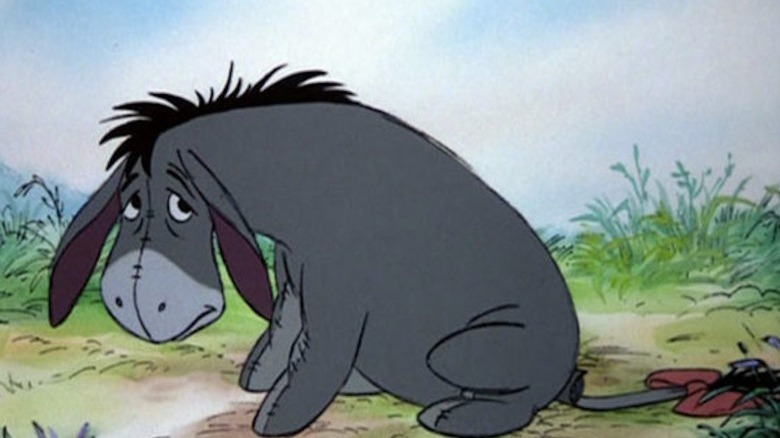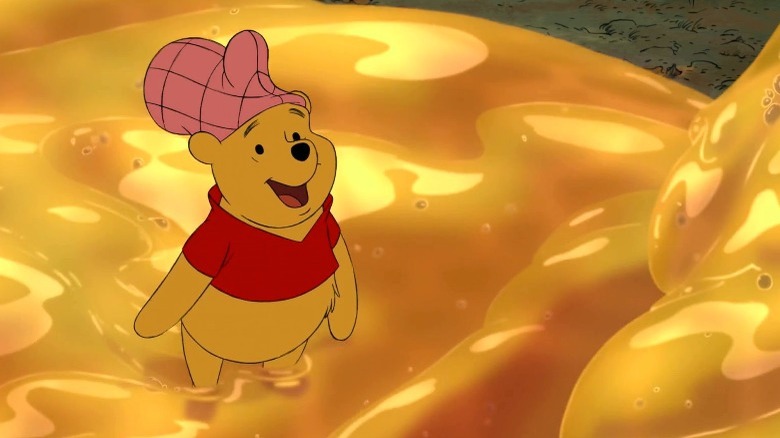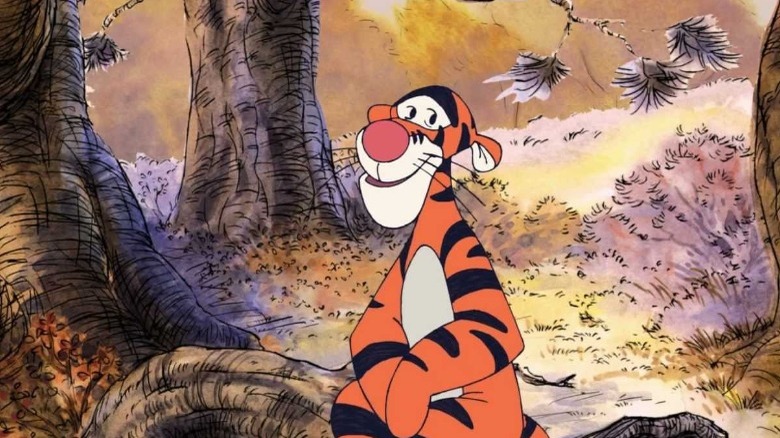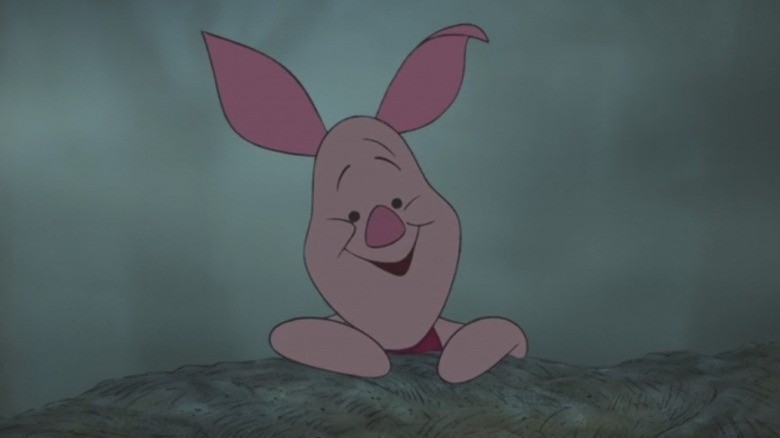15 Most Popular Winnie The Pooh Characters Ranked Worst To Best
There's real magic in the world of Winnie the Pooh. The stories written by A.A. Milne and illustrated by Ernest Shepard were beloved for decades all over the world, and when the characters got the Disney treatment, they received an even greater level of love and appreciation. The stuffed animals who'd come to life in the Hundred Acre Wood made their big-screen debut in 1977's "The Many Adventures of Winnie the Pooh," considered by some to be among the best Disney films.
Since then, Winnie the Pooh has continued to be a major cultural touchstone, in part thanks to the memorable characters that give life to the films, television shows, and endless waves of merchandise. With so many lovable denizens of the Wood, who is the very best of them all? Focused squarely on the Disney versions of these characters, here are 15 of the most popular Winnie the Pooh characters, ranked.
Darby
Not to be confused with Winnie's frequent play pal Christopher Robin, Darby (Chloe Grace Moretz) was introduced in the 2007 – 2010 Disney Junior computer-animated television show "My Friends Tigger & Pooh." The head of the Super Sleuths, Darby takes great joy in solving mysteries around the Hundred Acre Wood with her stuffed friends. For those wondering where Christopher Robin was during this show, well, it was set at a time when he had grown up — and although never confirmed, some presumed that Darby was his younger sister (the Disney Fandom page says she is his "younger best friend").
Though she lacks the impact and occasional wisdom of Christopher Robin, Darby is a sweet addition to the world of Winnie the Pooh. Boating a warm personality and pet dog named Buster, she got the job done in making playtime possible. You'll never see Darby in a dress, as she's a bit of a tomboy. Sure, she was friendly and clever enough — but quite frankly, she's only interesting for viewers who are very, very young.
Kessie
For those who have only seen the Winnie the Pooh movies, you may have done a double-take reading the name Kessie. She's an adorable baby bluebird who made her debut in the 1988 – 1991 series "The New Adventures of Winnie the Pooh," and later returned for the 2001 – 2004 animated series "The Book of Pooh."
Voiced by Laura Mooney (and later, Stephanie D'Abruzzo), when we first met Kessie, she was a baby who was mostly seen screaming, giggling, and crying. Rabbit found himself slowly drawn to her, overcoming an initial hesitancy to care for her, but eventually going so far as to adopt her.
Kessie is a sweet, charming character — one memorable "New Adventures" scene depicted a highly emotional moment as the now-grown bird flew away to return to her family. Though it seems like Kessie leaves without saying goodbye, breaking Rabbit's heart (and ours), her giggle resonates and she suddenly appears, taking the time to say goodbye properly. Kessie doesn't do a whole lot except be cute and adorable (not necessarily a bad thing), but she knows her sweet spot and she never fails to hit it.
The Narrator
From the original Winnie the Pooh stories written by A.A. Milne to the Disney iterations, the narrator has always played a vital part in Pooh's stories. In the Disney films, particularly 1977's "The Many Adventures of Winnie the Pooh" (voiced by Sebastian Cabot) and 2011's "Winnie the Pooh," (John Cleese) the narrator was a character unto his own, regularly interacting with the characters in the story. It's a considerable departure from most classic Disney films, where a narrator would only read from a storybook at the beginning of a film to set the plot in motion, then recede into the background.
The narrator is so essential in 2011's "Winnie the Pooh," in fact, that the plot wouldn't be able to move forward without him. The characters, especially Pooh, regularly interact with words in the storybook during that film — and in one pivotal moment, use them to climb out of a pit to safety.
The Backson
Originally introduced in the "The House at Pooh Corner," this character (whose name comes from a humorous mis-reading of a sign that says "Back Soon"), most memorably appeared in the 2011 film "Winnie the Pooh."
The Backson continues the grand tradition of Heffalumps and Woozles, serving as the "villain" of the film. Although he's never actually seen until the very end, his presence is felt throughout as the Pooh crew fear the unknown he represents.
Throughout the movie, they speculate as to what the "vicious" Backson could be capable of doing — leading to a standout musical number. Supposedly, this terrifying creature scribbles in your books, tangles up your Christmas tree, puts holes in your socks, messes up your house, and — heaven forbid — never begs your pardon.
If you stick around for the end of the credits of "Winnie the Pooh," you finally hear the Backson speak for the first time. As it turns out, he's not only real, but also friendly and sweet.
Gopher
Gopher (originally Howard Morris, Michael Gough since 1988) stands out for an interesting reason — he's the only character to appear in "The Many Adventures of Winnie the Pooh" that wasn't part of the original book series written by A.A. Milne. Disney wanted a character that felt a bit more distinctly American, to give audiences a more relatable Wood resident. There's even a clever nod to this in the film; Gopher's very first line is "I'm not in the book, but I'm at your service."
Though he's a charming and funny presence in the 1977 film, he's a notable absence in the 2011 movie, perhaps because he wasn't quite the success that Disney was hoping for. That said, he's still a big presence in a number of Winnie the Pooh television shows, and has a great role in "The New Adventures of Winnie the Pooh." Because Gopher is, well, a gopher, he spends a lot of time underground, and only the top half of him is typically visible. He's a hard worker and top-tier whistler, but he's mostly there out of necessity, and there isn't much depth to his personality.
Lumpy
Heffalumps are supposed to be an absolute nightmare, and in their first appearance in Disney's Winnie the Pooh universe, that's taken quite literally. The elephant-like Heffalumps appear in the magnificent nightmare in "The Many Adventures of Winnie the Pooh," yielding one of Disney's more stylistic, trippy sequences. As it turns out (per 2005's "Pooh's Heffalump Movie"), despite the gang's fears, Heffalumps aren't so terrifying after all.
The purple Heffalump Lumpy (Kyle Stanger) proves the creatures are far more charming and approachable than you'd think. He's incredibly sweet and playful, and far more interested in eating vegetables than any of the characters in the Hundred Acre Wood.
It's such a pleasure to watch Lumpy's relationship with Roo evolve over the film, and the two even sing the sweet Carly Simon song "Shoulder to Shoulder" together in a celebration of their friendship. In addition to being adorable, Lumpy provides valuable lessons for kids: The things you hear aren't always true, and looks can be deceiving.
Christopher Robin
Without Christopher Robin (voiced by Jack Boulter), it's fair to say that Winnie the Pooh wouldn't exist — after all, the origins of A.A. Milne's books come from his relationship with his own son, the real life Christopher Robin. Which, admittedly, wasn't always a good thing.
In the Disney iterations, the character is largely defined by his relationships with the other characters, particularly the very special emotional bond he shares with Pooh. In the shows and films, he's often only present at the beginning and end, and many of the stories revolve around finding him. He often imparts some valuable wisdom to Pooh, telling him in 1997's "Pooh's Grand Adventure: The Search for Christopher Robin": "You're braver than you believe, stronger than you seem, and smarter than you think."
The character even got his own film in 2018's Ewan McGregor-starring "Christopher Robin," a live-action flick that depicted him as a grown up, reminding us that he's not a very interesting character on his own.
The fact is, Christopher Robin has always been a blank slate, meant for kids to project themselves onto rather than being a fully fleshed-out character. In the "Christopher Robin" live-action movie, it's only when the gang from the Hundred Acre Wood appears that the film kicks into high gear. In short, he gets by with a little help from his friends.
Kanga
Kanga has perhaps the warmest presence of anyone in the Hundred Acre Wood, making hearts melt with a single word; just watch how Tigger reacts when Kanga calls him "dear." Despite being a real sweetheart, Kanga hardly ever joins the gang on their adventures, typically staying home while her boy Roo goes out with the gang instead.
Though Kanga is often in the background, she's always the voice of reason and the quasi-straight man when it comes to this group of wonderfully erratic characters. Thankfully, in films like "Pooh's Heffalump Movie" and "Springtime With Roo," Kanga gets some more time to showcase what makes her such a warm and inviting presence, though it's almost always in relation to Roo.
That's not to say Kanga never gets her time to shine, and she's capable of a delightful one-liner, like when Eeyore is revealed as "Exhibit A" in "Winnie the Pooh" and Kanga dryly says, without missing a beat, "Oh! That is tragic." She's also a fantastic mother though, and always encourages Roo to follow his dreams while ensuring he grows up to be a thoughtful, loving young boy.
Owl
Every friend group has one: the know-it-all. They're quick to correct, quick to drop a fact or two, and always thrilled to tell you about their (not so) thrilling academic exploits.
In the Hundred Acre Wood, that character is absolutely Owl (originally Hal Smith, comedian Craig Ferguson in the 2011 film), the resident scholar who doesn't know nearly as much as he thinks he does. He's also no better at spelling than anyone else, even if he thinks he is, and so frequently leads the characters of Winnie the Pooh off on a wild goose chase. This is best exemplified in the 2011 movie, where he engineers the Backson expedition.
Sure, Owl has a well-earned reputation for being arrogant and overwhelmingly smug, but there's something quite lovely about him. That's likely because, when it comes down to it, Owl really isn't all that clever, and just wants to be considered very wise. If Owl was as smart as he thinks he is, he'd just come across as rude, but since he isn't in fact intellectually superior to anyone else, it lends a relatable element to the character.
Roo
Curious, inquisitive, and adventurous, Roo (voiced by everyone from Clint Howard to Wyatt Dean Hall in 2011's "Winnie the Pooh") is the youngest character in the Hundred Acre Wood, but he's without a doubt one of the most charming presences in the Winnie the Pooh universe. Roo has become quite popular over the years, was awarded one of the lead roles in "Pooh's Heffalump Movie," and even got his own film in the sweet 2004 straight-to-video film "Springtime With Roo."
In "Heffalump," fans got to see a lot of what makes Roo a unique presence: While everyone else became convinced Heffalumps were evil and should be avoided at all costs, Roo was more trusting, determined to discover the truth about them since nobody had actually met one before.
One of Roo's strongest relationships is buoyed by his undying love for Tigger, who he sees as a father figure. The pair frequently bond over the endless joy that bouncing around brings them, and Tigger is always pushing Roo to bounce bigger and better, which thrills him. While the rest of the Hundred Acre Wood is quite satisfied to keep things the same, Roo is markedly different for his innate desire to explore and discover new things, speaking to the adventurer in all of us.
Rabbit
When it comes down to it, Rabbit (originally Junius Matthes, Tom Kenny since 2011) just wants to be left alone. He has a lovely home in a large tree with an impressive garden, and he'd probably be in complete bliss 24/7 if not for being constantly exasperated by his friends. Rabbit's patience is regularly tested, and nobody is more responsible for his frustration than the charming Winnie the Pooh.
In 1977's "The Many Adventures of Winnie the Pooh," part of Rabbit's house is shown to be underground, with a small hole in a hill to enter. An impressive decorator, Rabbit has managed to make great use of his limited space, clearly enjoys being by himself, and is absolutely devastated when Pooh comes to visit.
In one of Pooh's most beloved gags, he ends up eating so much Honey that he gets himself stuck in Rabbit's doorway. Despite the initial panic, Rabbit makes the best of a bad situation, decorating Pooh's bottom and turning it into a fashionable set-piece that really ties his house together. He even manages to get that "rustic, informal look" — but as it so often the case for Rabbit, things come crashing down around him when Pooh finally breaks free.
That moment is a microcosm of what makes Rabbit so much fun. Sure, we all love spending time with our friends, but sometimes it's preferable to be by yourself, unencumbered from the stresses of the world — and Winnie the Pooh's bottom.
Eeyore
Speaking of characters who never seem to catch a break, everyone's favorite tragic donkey is next on the list. Spectacularly gloomy Eeyore (originally Ralph Wright, Brad Garrett in the 2011 film) has become synonymous with being negative, and the character has had such an enormous impact on contemporary society that if you refer to someone as an "Eeyore," everyone knows exactly what you mean.
Perhaps Eeyore's living arrangements contribute to his depressed demeanor; while everyone else has a nice, sturdy home, Eeyore has ... a pile of sticks fashioned together to form a sort of tent (of which he says: "Not much of a house, just right for not much of a donkey."). His flimsy walls are often falling down thanks to Tigger's bouncing, and everything in the Hundred Acre Wood just seems to compound his ennui.
While Eeyore might not appreciate his own magnificence, his friends can always be counted on to try and brighten up his day, even if it hardly ever works. Though Eeyore clearly struggles with his outlook on the world, it never stops his friends from wanting to spend time with him and include him, which provides an important message to not give up on your friends while they are struggling.
Fans love Eeyore so much that he makes number 4 on this list, with or without his tail. As the stuffed donkey would put it: "Thanks for noticing me."
Winnie the Pooh
The ultimate icon for the body positivity movement ("I am short, fat, and proud of that"), Winnie the Pooh (originally Sterling Holloway, now Jim Cummings) is nothing short of a pop culture icon. We'll try not too pontificate too much – long words bother Pooh, after all.
One of Pooh's most relatable aspects is his constant hunger, speaking to the snack lover in all of us. He's particularly enamored by "hunny," and will do anything for the next opportunity to stick his hand into an ooey gooey pot.
Once, he scaled a tree to get his favorite treat straight from the beehive source — which ended up exactly as you would expect. In "Winnie the Pooh," his hunger made him hallucinate a visually sumptuous world (featuring the wonderful song "Everything is Honey"), only to wake up and realize he'd been eating mud.
It's not just Pooh's appetite that make him so relatable, however. This silly old bear has charm to spare, a knack for dropping pearls of wisdom when least expected, and although he's not the smartest or bravest bear around, he is the most lovable. Perhaps best summing up his adorable nature is one of Pooh's classic quotes: "People say nothing is impossible. But I do nothing every day."
Tigger
The singing, bouncing, all-around goodest boy Tigger (originally voiced by Paul Winchell, Jim Cummings in the 2011 film) is one of the all-time great children's characters in any medium. His first Disney appearance came in the 1968 featurette "Winnie the Pooh and the Blustery Day," where he comes bursting through the door, pouncing on Pooh, telling us his name is spelt "T-I-double-guh-ER."
Ever since, Tigger's personality has been unfailingly enthusiastic; if he gets his way, you can bet he's going to be the center of attention. Stop paying attention to him for too long, and he may just bounce on you.
There's nobody in the Hundred Acre Wood who doesn't love Tigger; perhaps he and Pooh have such a strong relationship because Tigger doesn't like honey, and therefore wouldn't dream of diminishing Pooh's supply. While Tigger is certainly a dominant personality, he's also relentlessly optimistic, with an undeniable energy that makes him someone you want to have around. He also has a heartwarming relationship with Roo, and the two share a love for Tigger's favorite thing in the world: bouncing. Their wonderful brotherly companionship was at the center of Tigger's very own starring moment, 2000's "The Tigger Movie."
As this complete, total original might say: "The most wonderful thing about Tiggers, is I'm the only one!" Thank goodness.
Piglet
"Oh, d-d-d-dear," Piglet (originally John Fielder, Travis Oates in the 2011 film) often says, as he cowers in fear at what seems like the drop of a hat. It's easy to see his nervous stature and small size and dismiss him entirely, but doing so would be a dreadful mistake.
Time and time again, Piglet faces his fears and overcomes his miniature size to accomplish great things. He's also quite hilarious; in 2011's "Winnie the Pooh" Piglet has the opportunity to save his friends who have fallen into the trap they created, and in an effort to keep things fair for all, he cuts the rope into six pieces, claiming "now you can all get out!" His comical blunder forces him to brave the terrifying forest to find help, something that despite plenty of shuddering and shivering, he succeeds in.
Piglet is also gracious and a friend everybody should aspire to be like. When Owl's house gets blown away in "The Many Adventures of Winnie the Pooh," Piglet graciously offers Owl his own home. That's to say nothing of his fashion sense, as Piglet's magenta sweater is truly the stuff that dreams are made of; in a contest based purely on cuteness, he wins the gold hands down.
But the real reason Piglet is the best "Winnie the Pooh" character is because he offers children an extraordinary message, that bravery can come from even the most unexpected source. Whether it is a dark forest, a ruined home, or rescuing Pooh from danger (as in "Piglet's Big Movie"), you can always count on this little pig to get the job done.
